The Arts on Stamps of the World — November 30
An Arts Fuse regular feature: the arts on stamps of the world.
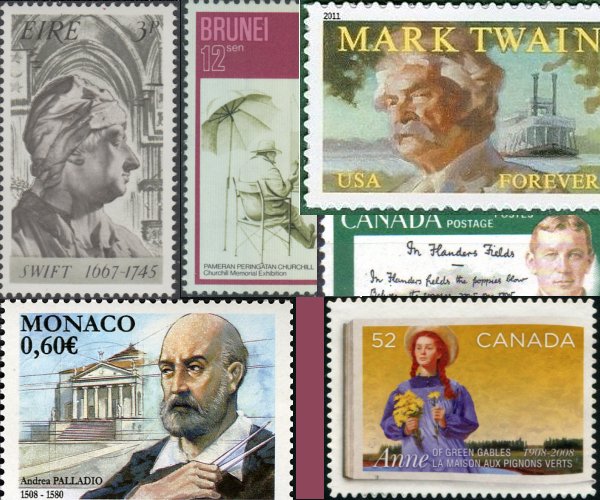
By Doug Briscoe
Two titans of literature, Jonathan Swift and Mark Twain, were both born on November 30th, as were two great Italian architects, Andrea Palladio and Andrea Pozzo. Joining them are Winston Churchill (in artist mode), French painter William-Adolphe Bouguereau, the Canadian writers who gave us “In Flanders Fields” and Anne of Green Gables, and the world’s current reigning chess champion, along with Billy Idol.

The great Jonathan Swift (30 November 1667 – 19 October 1745) was born in Dublin, though both parents had been born in England. On the subject of Swift’s family, it’s interesting to note that he was related to John Dryden (his grandmother’s uncle was Dryden’s grandfather), Sir Walter Raleigh (again through his grandmother, who was cousin to Raleigh’s wife), and Sir William Davenant, a playwright and godson of Shakespeare (through his uncle, who married Davenant’s daughter). Swift’s own friends included Alexander Pope and John Gay. He was Dean of St Patrick’s Cathedral in Dublin from 1713 till his death. The Irish stamps show the author and his most famous creation, Gulliver, who appears also on a more recent Irish issue and on stamps from Hungary and Monaco. Romania also paid him tribute on the occasion of his tercentenary.
Mark Twain (Samuel Langhorne Clemens) was born on this date in 1835. That his wit is inexhaustible seems to be literally true, for I’m constantly coming across funny sayings of his that I’ve never encountered before. And how I admire his ability to pierce through nonsense, hypocrisy, and humbug with a trenchant quip! A few pieces of classical music owe their existence to Clemens, the second movement of Ferde Grofé’s Mississippi Suite (1926), entitled “Huckleberry Finn”, George Antheil’s Tom Sawyer Overture (1949), Lukas Foss’s opera The Jumping Frog of Calavaris County (also 1949), and a new ballet on Tom Sawyer by composer Maury Yeston, which had its first performance on October 14, 2011 in Kansas City, Missouri. The first Mark Twain stamp was issued by the United States in 1940. Romania comes through once again, as does Hungary. Another US Clemens stamp just came out in 2011. Next to that is one from the Comoros Islands. I like the way the Russian stamp (at bottom center) transliterates his name as Mark Tven. Two more US stamps recall Tom Sawyer (a Norman Rockwell painting, which also shows up on the new San Marino stamp) and Huckleberry Finn. Clemens was famously born in a Halley’s Comet year and predicted that he would “go out with it.” I don’t suppose even he imagined that he would die on April 21, 1910, the very day after the comet returned. At bottom right, a clever design from the Turks and Caicos Islands shows Clemens riding the comet with gusto.
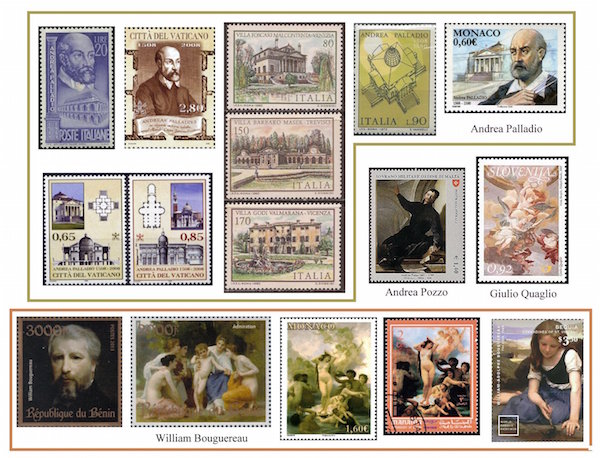
Andrea Palladio (30 November 1508 – 19 August 1580) was one of the most influential architects in history. His buildings are not widely dispersed geographically, but the principles articulated in Palladio’s treatise The Four Books of Architecture had far-reaching consequences indeed. He was born Andrea Di Pietro della Gondola in Padua and learned stonecutting and masonry in sculptors’ workshops there and in Vicenza. Through an employer, the Humanist poet Gian Giorgio Trissino (who dubbed him “Palladio”), he was introduced to the work of the ancient Roman architect Vitruvius, and this inspired him to rediscover the principles of the classical style. He designed many palaces and churches, but it is for his villas that Palladio is perhaps most celebrated. The three Italian stamps aligned vertically at center show three examples, Villa Foscari (designed about 1554 and built 1560-65), Villa Barbaro (built 1554-58), and Palladio’s first commission, Villa Godi (conceived 1537, built 1539-57). The 2008 pair of stamps from the Vatican (at bottom left) show Palladio’s Villa Capra, called “La Rotonda”, and Church of San Giorgio Maggiore in Venice. The Villa Capra, designed 1566-67 and built between 1567 and 1605, also appears on stamps of Italy (in a bird’s eye view) and Monaco.
Above I referred to Andrea Pozzo (30 November 1642 – 31 August 1709) as an architect, which indeed he was, but he is best known for his splendid frescoes employing trompe-l’œil and quadratura effects. The finest example of this may be his extraordinary nave ceiling of the Church of Sant’Ignazio (1685) in Rome. Such is the mastery of these illusionist pieces that they had a lasting influence for generations. Born in Trento, Pozzo traveled to Como and Milan, Genoa and Venice. As a young man he became a lay brother with the Jesuits. Since many of the Order’s churches were recently built, there was much demand for artistic decoration, and Pozzo was frequently employed in that office (Modena, Bologna, Arezzo). In 1681 he went to Rome to work mainly as a stage designer for religious pageants, and his paintings for these projects helped spread his repute. He was recommended to the Holy Roman Emperor Leopold I and went to Vienna in 1702 or 1703. For the Jesuit Church in that city he created the magnificent ceiling that simulates the presence of a dome. As for architecture, Pozzo made the plans for Ljubljana Cathedral (1700) and was intending to design a new Jesuit church for Venice when he died in Vienna. Unfortunately, I was not able to find a stamp showing the cathedral, and we must make do with one illustrating the work of Giulio Quaglio (1610–1658 or after), who painted the frescoes. Pozzo was also important as a theoretician, having published his Perspectiva pictorum et architectorum in two volumes (1693, 1698) with 118 engraved illustrations. The only stamp we seem to have for Pozzo is one from the Sovereign Military Order of Malta showing his highly original self-portrait. This was the result of a request specifically made in 1681 by Cosimo III de’ Medici. The painter shows himself in a diagonal pose, pointing to his work and resting his hand, presumably, on his theoretical tomes. Most online versions of this self-portrait crop and tilt the image to make it look straight!
>
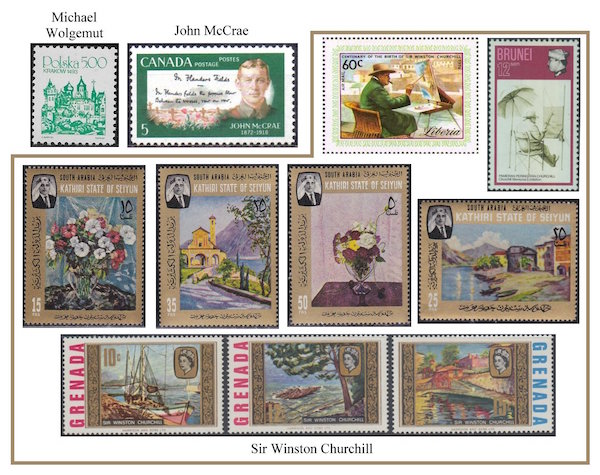
French academic painter William-Adolphe Bouguereau (November 30, 1825 – August 19, 1905) was hugely popular and productive while at the same time being held in contempt by the New Breed of Impressionists like Matisse and Gauguin, who saw in him everything they detested in old, fusty academicism. He was born in La Rochelle and frequently returned there from Paris, whither he had moved in his youth to seek his fortune as a painter. He won the Prix de Rome in 1850 with his work Zenobia Found by Shepherds on the Banks of the Araxes and spent three years at the Villa Medici. He was not only a prolific painter (of some 822 canvases), he also had hundreds of students. His most famous pupil, Elizabeth Jane Gardner, became his second wife. First among the stamps we see his Portrait of the Artist (1879) and Admiration (1897), both taken from a Sheet issued by Benin in 2013. One of his most popular canvases, The Birth of Venus (1879), shows up on stamps of Monaco and Manama. Finally, we offer The Crab (1869) on a stamp from the Grenadines island of Bequia.
Now we go back to the year 1434 for the birth of German painter and printmaker Michael Wolgemut, who died on this date in 1519. He learned from his father and the Nuremberg artist Hans Pleydenwurff and in turn was a teacher of Dürer. Wolgemut married Pleydenwurff’s widow and took charge of the decedent’s workshop, which he maintained as a thriving concern with many apprentices. He adopted Pleydenwurff’s son Wilhelm, who later became his partner. Wolgemut was a leading force in reviving the art of the woodcut, as exemplified in the illustrations for the Nuremberg Chronicle (or Historia mundi—History of the World) by Hartmann Schedel (1493), but he also left a number of admired paintings in the form of retables and altarpieces. One of the better known pieces from the Historia is the Dance of Death. The only stamp I could locate for Wolgemut is one reproducing a print of the city of Kraków made in 1493, and that may be a collaborative effort with Pleydenwurff.
Having already seen today’s 17th- and 18th-century artists, we must suddenly return to modern times and the Canadian physician John McCrae (November 30, 1872 – January 28, 1918), who, as a poet, is really known for just a single work, the war memorial poem “In Flanders Fields”. He had, however, written poetry as early as his college years while studying medicine. Professionally, he was a resident at both Toronto General Hospital and Johns Hopkins in Baltimore, then a pathologist at Montreal General Hospital. McCrae served in the Boer War as an artillery officer and in World War I as a surgeon, notably in makeshift conditions during the Second Battle of Ypres in 1915. In that battle McCrae’s friend Alexis Helmer was killed, and it was his burial that directly inspired the famous poem. It was at first published anonymously in Punch, but McCrae was identified as the author in that year’s index, and he became a celebrity overnight, as the poem was broadly used in support of the war effort. “In Flanders Fields” was set as a song by such disparate composers as Charles Ives and John Philip Sousa. McCrae rose to the rank of Lieutenant Colonel and died of pneumonia in the last year of the war.
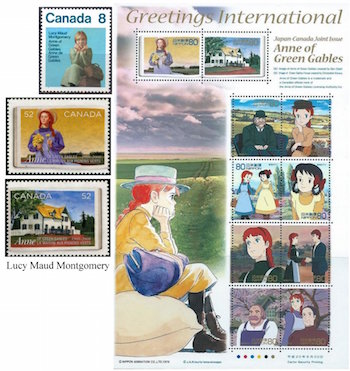
You probably know that Sir Winston Churchill (30 November 1874 – 24 January 1965) also served in the Boer War as a correspondent and had something to do with World War I as well. But today we come not to praise Churchill’s great statesmanship but his good painting. Of course, he also wrote voluminously and brilliantly on history (and won the Nobel Prize for it in 1953), but you may not know he produced a novel called Savrola that was serialized in Macmillan’s Magazine from 1898 to 1900. As for his painting, it was an avocation that he practiced throughout his life, particularly after the Gallipoli debacle and his resignation from the Admiralty in 1915. Churchill suffered greatly from depression, and painting diverted him from that curse. Most of his canvases are impressionist landscapes, and samples of them have been reproduced on postage stamps, notably on sets from Grenada and the Kathiri State of Seiyun. I show a selection of them along with some other stamps that portray the great man at his easel.
Back to Canada now for Lucy Maud Montgomery (November 30, 1874 – April 24, 1942), author of the novels about Anne Shirley, that is, Anne of Green Gables. Montgomery was a teacher from Prince Edward Island who at sixteen published a poem in Charlottetown’s Daily Patriot in 1890. Before the end of the decade she was being regularly represented in periodicals with her stories, more than 100 of them between 1897 and 1907. Anne of Green Gables came out the following year. Always a prolific writer, Montgomery published twenty novels (seven more in the Anne series), over 500 short stories and 500 poems. (Actually, there is a ninth Anne book, The Blythes Are Quoted, submitted for publication before Montgomery’s death but not published in full until 2009!) I must quote fellow birthday child Mark Twain, who described Anne as “the dearest and most moving and delightful child since the immortal Alice”.The first Montgomery stamp was issued by Canada in 1975. Another issue of two stamps from 2008 came out in conjunction with a Japanese sheet. Note, if you can see it, that the top two stamps on the sheet use the same design as the Canadian pair. The first of those two designs is drawn from “Beyond the Summer Fields”, a print by American artist Ben Stahl. The other stamps on the sheet reflect the animated series on Anne of Green Gables (Akage no An, Red-Haired Anne) that ran on Japanese television in 1979.
Russian artist Ivan Dubasov (30 November 1897 – 15 March 1988) did a great deal of work designing Soviet banknotes (like this three ruble bill from 1925), stamps, medals, and more over a career lasting several decades. Here on AoSotW we’ve already seen a few stamps that came from Dubasov’s hand, including ones for critic Vladimir Stasov and artists Viktor Vasnetsov and Isaac Levitan. Another Dubasov design, for artist Nikolay Nekrasov, is coming up in ten days. For now, here are some Dubasov stamps on topics unrelated to the arts. One is for the zoologist and immunologist Ilya Mechnikov (1845-1916); one is an early Soviet special delivery stamp from 1932; and one is a wartime issue depicting a Red Army sniper. The two-toned stamp celebrates 25 years of the Soviet postal system.
English rocker Billy Idol turns 62 today. He was born William Michael Albert Broad and achieved stardom in the 1970s with the punk rock band Generation X. They released three albums before Idol left to go solo in 1981. The stamp comes from Guinea-Bissau.
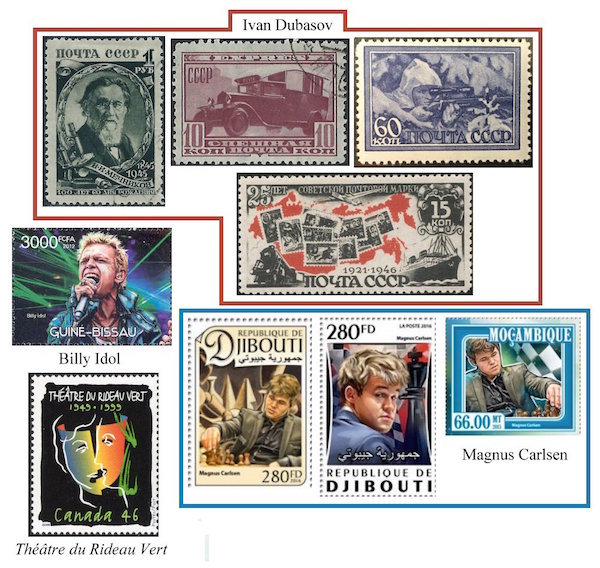
The world’s current champion chess player is Norwegian grandmaster Magnus Carlsen (born 30 November 1990). A child prodigy, he attained grandmaster status at 13½. He has been the World Champion since defeating Viswanathan Anand in 2013. Carlsen can boast the highest rating in the history of the game: 2882.
On this date in 1948, Montreal’s Théâtre du Rideau Vert, the first professional French-language theater in Canada, was founded. It opened on February 17, 1949 with a performance, oddly enough, of The Innocents by Lillian Hellman, a play that had of course been written in English. The stamp announces the fiftieth anniversary of that opening.
Appalling, I know, but there’s no stamp for Sir Philip Sidney (30 November 1554 – 17 October 1586). A number of noteworthy figures from cinema share this November 30 birthday, Gordon Parks (1912 – March 7, 2006), Ridley Scott (born 1937), and Terrence Malick (1943), and happy birthday, too, to David Mamet (born 1947) and Mandy Patinkin (1952).
A graduate of the University of Massachusetts with a B.A. in English, Doug Briscoe worked in Boston classical music radio, at WCRB, WGBH, and WBUR, for about 25 years, beginning in 1977. He has the curious distinction of having succeeded Robert J. Lurtsema twice, first as host of WGBH’s weekday morning classical music program in 1993, then as host of the weekend program when Robert J.’s health failed in 2000. Doug also wrote liner notes for several of the late Gunther Schuller’s GM Recordings releases as well as program notes for the Boston Classical Orchestra. For the past few years he’s been posting a Facebook “blog” of classical music on stamps of the world, which has now been expanded to encompass all the arts for The Arts Fuse.
